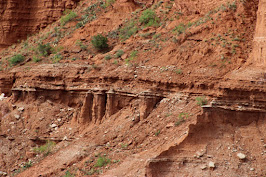Day 22 – A Hidden Canyon
Our path led us through the northern portion of the Texas panhandle, and our destination was a state park called Caprock Canyon. However, as we drove we were traveling through an arid prairie with very few low hills, let alone a canyon.
Even
just five miles from where the GPS said we were headed the land was flat. Was
there really going to be a canyon?
Then, a couple of miles from the campground, we began to see some breaks in the ground where the erosion had exposed the red earth layers so often seen in the desert southwest. We turned in to the park entrance and approached the ranger station to be greeted by the view of a canyon wall in the distance. We were also surprised to see a small herd of bison grazing around the parking lot! Some of these woolly giants strolled amongst the parked vehicles to reach the grass on the other side.
We had heard that the park was home to a herd of bison, but we didn’t think we would see them up close without even having to drive to another part of the park. Needless to say, the cameras were quite busy snapping pictures.
There is an eight mile drive further into the park where you can get some magnificent views of different formations of the canyon. The top layer of the canyon, the Ogallala Formation, was created about 10 million years ago. It is topped with a hard layer of white caliche which was a mineral deposit. That is the “cap rock” that gives the canyon its name and also for millennia it protected the area from erosion.
The
middle layers of the canyon were formed about 210 million years ago. They are
the brown, orange, and gray layers of the Dockum Group which were created by
freshwater streams leaving gravel deposits.
Finally, the lower portion of the canyon is mainly the dark red Permian layer which was formed when this area was covered by an inland sea about 250 million years ago. This layer also has hard white veins of gypsum where the seawater evaporated leaving concentrations of minerals.
 So
much for the geology lesson. In short, this marvel began millions of years ago
and today we can enjoy the majesty of the cliffs that have been exposed. We found several locations in the park where we could sit and admire the rugged terrain. We enjoyed the quiet solitude that was only broken by the peaceful sound of happy birds in the surrounding mesquite bushes.
So
much for the geology lesson. In short, this marvel began millions of years ago
and today we can enjoy the majesty of the cliffs that have been exposed. We found several locations in the park where we could sit and admire the rugged terrain. We enjoyed the quiet solitude that was only broken by the peaceful sound of happy birds in the surrounding mesquite bushes.
What a hidden gem this canyon was to visit.









Comments
Post a Comment